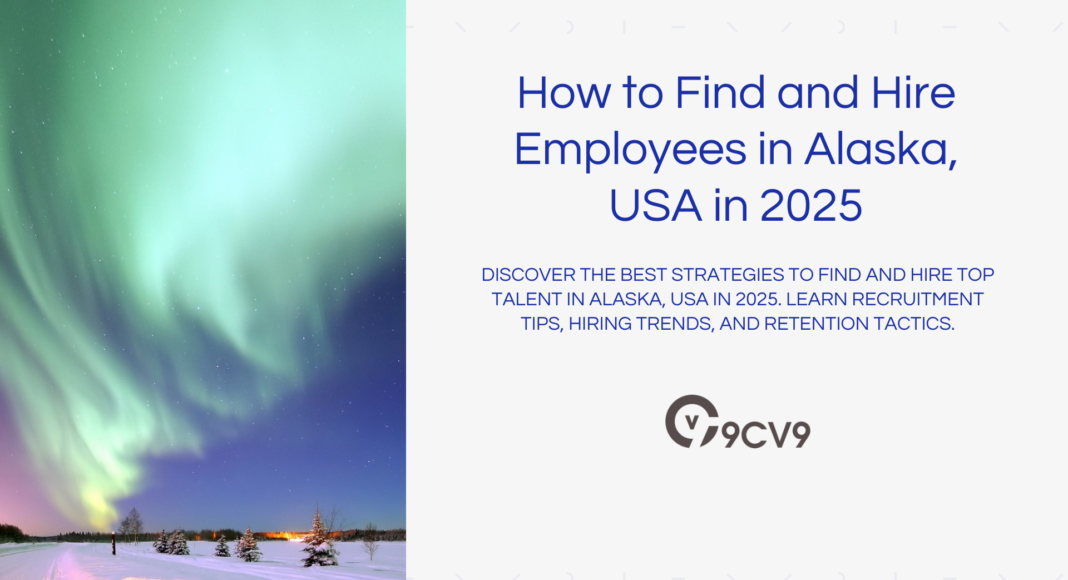Key Takeaways
- Leverage multiple hiring channels like online job portals, recruitment agencies such as 9cv9, and local workforce programs to find top talent.
- Offer competitive salaries and benefits to attract skilled employees, considering Alaska’s high cost of living and industry-specific demands.
- Implement retention strategies such as career development programs, flexible work options, and strong workplace culture to reduce turnover.
Hiring employees in Alaska presents unique challenges and opportunities for businesses in 2025.
With its vast geographic expanse, harsh winters, and a labor market influenced by seasonal industries, finding and retaining qualified employees requires a strategic approach.
Whether you are a local business, a startup, or an established company expanding into Alaska, understanding the nuances of recruitment in this state is essential for long-term success.

Alaska’s economy is driven by key industries such as oil and gas, fisheries, healthcare, tourism, and technology.
Many of these sectors face labor shortages due to the state’s relatively small population and the transient nature of its workforce.
Additionally, the rising trend of remote work has opened new possibilities for companies seeking talent beyond Alaska’s borders.
However, employers must also navigate state-specific labor laws, competitive salary expectations, and logistical challenges such as relocation assistance and workforce housing.
In 2025, technological advancements and evolving hiring trends have reshaped recruitment strategies.
Employers are increasingly leveraging AI-powered recruitment tools, online job portals, and social media platforms to connect with potential candidates.
Local job fairs, apprenticeship programs, and university partnerships have also become critical in addressing workforce demands.
Additionally, businesses are exploring innovative hiring incentives, such as flexible work arrangements, signing bonuses, and employee retention programs, to attract top-tier talent in Alaska’s competitive job market.
This guide provides a comprehensive overview of how businesses can successfully find and hire employees in Alaska in 2025.
From understanding the current job market and utilizing the right recruitment channels to navigating labor laws and implementing retention strategies, this article equips employers with the knowledge needed to build a strong and sustainable workforce in one of the most unique labor markets in the United States.
Before we venture further into this article, we would like to share who we are and what we do.
About 9cv9
9cv9 is a business tech startup based in Singapore and Asia, with a strong presence all over the world.
With over nine years of startup and business experience, and being highly involved in connecting with thousands of companies and startups, the 9cv9 team has listed some important learning points in this overview of How to Find and Hire Employees in Alaska, USA in 2025.
If your company needs recruitment and headhunting services to hire top-quality employees, you can use 9cv9 headhunting and recruitment services to hire top talents and candidates. Find out more here, or send over an email to [email protected].
Or just post 1 free job posting here at 9cv9 Hiring Portal in under 10 minutes.
How to Find and Hire Employees in Alaska, USA in 2025
- Understanding the Job Market in Alaska
- Where to Find Qualified Employees in Alaska
- The Hiring Process in Alaska
- Competitive Hiring Strategies in Alaska
- Retaining Employees in Alaska
1. Understanding the Job Market in Alaska
Hiring in Alaska requires a deep understanding of the local labor market, which is shaped by a combination of industry demands, seasonal workforce fluctuations, and geographic challenges. As of 2025, businesses must adapt to evolving employment trends, technological advancements, and workforce expectations to attract and retain talent effectively.
This section explores the key industries driving employment in Alaska, workforce trends, and the challenges and opportunities employers face when hiring in the state.
Key Industries Hiring in Alaska in 2025
Alaska’s economy is driven by a few dominant industries that provide the majority of job opportunities. Employers must align their hiring strategies with industry-specific workforce needs to attract the right talent.
1. Oil and Gas Industry
- Continues to be a major employer, despite global shifts towards renewable energy.
- Companies such as ConocoPhillips, Hilcorp, and ExxonMobil are actively hiring engineers, technicians, and environmental specialists.
- Employment opportunities in pipeline maintenance, drilling operations, and offshore exploration.
- Increasing demand for professionals with expertise in sustainable energy and environmental compliance.
2. Fisheries and Maritime Industry
- One of the largest sources of employment, particularly in coastal regions like Dutch Harbor and Kodiak.
- Seasonal hiring peaks during fishing seasons, requiring thousands of temporary workers.
- Positions available in seafood processing, deckhand work, marine mechanics, and logistics management.
- Companies like Trident Seafoods and Icicle Seafoods often recruit international and out-of-state workers to meet labor demands.
3. Tourism and Hospitality Industry
- The tourism sector is rebounding strongly post-pandemic, with an increase in cruise ship arrivals and adventure tourism.
- Jobs available in hotels, restaurants, tour companies, and national parks.
- Hospitality workers, tour guides, chefs, and customer service representatives are in high demand.
- Seasonal employment surges in summer, especially in Anchorage, Juneau, and Fairbanks.
4. Healthcare and Medical Services
- The healthcare industry remains one of the most stable and fastest-growing sectors in Alaska.
- High demand for nurses, physicians, and healthcare administrators due to the state’s aging population.
- Rural healthcare facilities in remote areas often struggle to find skilled professionals.
- Programs such as the Alaska Loan Repayment and Incentive Program (SHARP) help attract medical professionals to underserved regions.
5. Technology and Remote Work
- The tech sector is expanding, with businesses leveraging remote work to hire talent from outside Alaska.
- Growth in cybersecurity, software development, and IT support roles.
- More companies are establishing remote work hubs, reducing reliance on in-state talent.
- Startups and small businesses in Anchorage and Fairbanks are actively hiring for digital marketing, e-commerce, and tech-driven roles.
Workforce Trends and Employment Rates in Alaska
Understanding workforce trends helps employers create more effective hiring strategies and adapt to changing labor market conditions.
1. Workforce Demographics
- Alaska has a relatively small workforce due to its low population density.
- A significant portion of the workforce is transient, with workers migrating in and out for seasonal jobs.
- Younger professionals are increasingly leaving Alaska for better job opportunities in the lower 48 states.
- Indigenous communities play a key role in Alaska’s labor market, with many employed in government, education, and healthcare.
2. Seasonal Employment Challenges
- Many industries rely on seasonal workers, leading to fluctuating workforce availability.
- Employers often struggle to retain workers during the off-season, requiring continuous recruitment efforts.
- Businesses in fishing, tourism, and construction sectors must plan ahead to secure labor before peak seasons.
- Incentives such as higher wages, signing bonuses, and temporary housing are often used to attract seasonal workers.
3. Unemployment Rates and Job Availability
- The unemployment rate in Alaska varies by region and industry.
- Remote and rural communities face higher unemployment rates due to limited job opportunities.
- Skilled labor shortages exist in specialized fields such as healthcare, engineering, and IT.
- Government initiatives and training programs aim to upskill local workers and reduce reliance on out-of-state hires.
4. The Rise of Remote Work in Alaska
- More companies are embracing remote work to tap into national and global talent pools.
- Employers offer hybrid work models to attract skilled professionals who prefer flexibility.
- Remote work infrastructure improvements, such as expanded broadband access, support this trend.
- Alaska-based companies in finance, tech, and customer service are hiring remote employees to overcome local talent shortages.
Challenges and Opportunities in the Alaskan Job Market
While Alaska presents unique hiring challenges, businesses can also capitalize on emerging opportunities to build a strong workforce.
1. Challenges of Hiring in Alaska
- Geographic Isolation: Remote locations make recruiting and retaining employees difficult.
- High Cost of Living: Housing shortages and expensive living costs deter some job seekers.
- Seasonal Workforce Dependence: Industries must continuously recruit due to high turnover rates.
- Skill Gaps in Critical Sectors: Shortages in healthcare, technology, and skilled trades create hiring challenges.
2. Opportunities for Employers
- Competitive Salary Offerings: Businesses that provide attractive compensation and benefits can secure top talent.
- Government Hiring Incentives: Programs supporting workforce development help businesses hire locally.
- Technology and Automation: Companies investing in AI-driven hiring tools can streamline recruitment efforts.
- Training and Apprenticeships: Developing local talent through on-the-job training programs can address skill shortages.
Conclusion
The Alaskan job market in 2025 is evolving, with industries adapting to economic shifts, workforce trends, and technological advancements. Employers must take a strategic approach to hiring, leveraging recruitment platforms, state workforce programs, and competitive benefits to attract and retain employees. By understanding the labor market dynamics and addressing hiring challenges proactively, businesses can position themselves for long-term success in Alaska’s unique employment landscape.
2. Where to Find Qualified Employees in Alaska
Finding qualified employees in Alaska requires a strategic approach, leveraging both traditional and modern recruitment channels. Given the state’s unique economic landscape, employers must explore multiple sourcing methods, including online job platforms, recruitment agencies, government programs, and local networking opportunities.
This section outlines the best places to find skilled workers in Alaska, including job boards, staffing agencies, educational institutions, and professional networks.
1. Online Job Portals and Recruitment Platforms
Digital hiring platforms have become a primary resource for employers looking to connect with qualified candidates. These job portals offer advanced search features, AI-driven candidate matching, and extensive databases of job seekers.
1.1 9cv9 Job Portal
- One of the leading job platforms connecting employers with skilled professionals across various industries.
- Specializes in helping businesses in Alaska find talent for remote, full-time, and contract positions.
- Offers AI-powered recruitment features, allowing employers to filter and shortlist candidates efficiently.
- Supports industries such as IT, healthcare, engineering, and tourism by providing a large pool of job seekers.
- Example: A tourism company in Anchorage looking for bilingual tour guides can use 9cv9’s platform to find qualified candidates with specific language skills.
1.2 9cv9 Recruitment Agency
- A trusted recruitment agency that assists employers in sourcing, screening, and hiring top talent in Alaska.
- Provides end-to-end recruitment solutions, including job posting, candidate interviews, and onboarding support.
- Helps companies in high-demand industries such as oil and gas, technology, and hospitality find the right employees quickly.
- Example: A seafood processing company in Dutch Harbor needing seasonal workers can partner with 9cv9 Recruitment Agency to secure a workforce before peak fishing season.
1.3 National and Local Job Boards
- AlaskaJobs – A state-run job board that connects employers with local job seekers across various industries.
- Indeed & Glassdoor – Popular job platforms where businesses can post openings and access a large talent pool.
- LinkedIn – Useful for recruiting professionals in industries such as finance, IT, and healthcare.
- Craigslist Alaska – Commonly used for entry-level and gig-based positions, such as construction and retail jobs.
- Example: A healthcare clinic in Fairbanks can use LinkedIn to find experienced nurses while also posting entry-level roles on AlaskaJobs.
2. Recruitment Agencies and Staffing Firms
Recruitment agencies specialize in finding, screening, and placing qualified employees based on employer needs. These firms help businesses save time and resources by handling the hiring process efficiently.
2.1 Industry-Specific Staffing Agencies
- Alaska Executive Search – Specializes in placing candidates in healthcare, finance, and management roles.
- NANA Workforce Solutions – Focuses on skilled trades, oil and gas, and government contracts.
- Opti Staffing Group – Provides recruitment services for administrative, logistics, and industrial positions.
- Example: A hospital in Anchorage struggling to find experienced medical technicians can work with Alaska Executive Search to fill positions.
2.2 Temporary and Seasonal Staffing Agencies
- Tundra Talent Solutions – Helps businesses find seasonal employees for tourism, hospitality, and fisheries.
- PeopleReady – Specializes in temporary labor for construction, warehousing, and logistics.
- Example: A fishing company needing workers for the summer salmon season can partner with Tundra Talent Solutions to ensure workforce availability.
3. Educational Institutions and Workforce Development Programs
Alaska has several universities, technical schools, and workforce development programs that serve as talent pipelines for businesses. Employers can build partnerships with these institutions to access job-ready graduates and skilled professionals.
3.1 Universities and Colleges
- University of Alaska Anchorage (UAA) – Offers degrees in business, engineering, and healthcare, producing a steady stream of qualified graduates.
- University of Alaska Fairbanks (UAF) – Known for its research programs in energy, fisheries, and Arctic studies.
- University of Alaska Southeast (UAS) – Specializes in maritime, tourism, and environmental science education.
- Example: A tech company in Anchorage can recruit software developers directly from UAA’s computer science program.
3.2 Technical and Vocational Training Schools
- Alaska Vocational Technical Center (AVTEC) – Provides training in welding, IT, marine technology, and healthcare.
- Ilisagvik College – Offers workforce training tailored to rural and Indigenous communities.
- Alaska Technical Center (ATC) – Focuses on construction, mechanics, and skilled trades.
- Example: A construction firm in Juneau can collaborate with AVTEC to hire trained welders for ongoing projects.
3.3 Government and Workforce Programs
- Alaska Workforce Investment Board (AWIB) – Supports job training programs to upskill local workers.
- Alaska Job Corps – Helps young adults gain technical skills and transition into full-time jobs.
- Veterans Employment Services – Connects employers with military veterans seeking civilian careers.
- Example: A logistics company in Anchorage can use AWIB programs to train and hire truck drivers.
4. Professional Networking and Local Hiring Events
Attending job fairs, networking events, and industry conferences can help employers connect with potential employees in person.
4.1 Career Fairs and Hiring Events
- Alaska Job Fairs (hosted by the Department of Labor) – Regular events featuring employers from various industries.
- University Career Expos – Allows businesses to recruit fresh graduates from Alaska’s colleges and universities.
- Industry-Specific Hiring Events – Oil and gas expos, healthcare recruitment fairs, and construction trade shows provide direct access to industry talent.
- Example: A hospitality company in Juneau can participate in a tourism job fair to hire seasonal hotel staff.
4.2 Local Business and Industry Associations
- Alaska Chamber of Commerce – Offers networking opportunities and job postings for businesses.
- Associated General Contractors of Alaska – Connects employers with skilled construction workers.
- Alaska Health Workforce Coalition – Supports healthcare recruitment initiatives.
- Example: A construction company can use the Associated General Contractors of Alaska network to find certified electricians.
4.3 Community and Indigenous Employment Networks
- Cook Inlet Tribal Council – Provides job placement services for Alaska Native communities.
- Sealaska Heritage Institute – Connects employers with Indigenous job seekers in Southeast Alaska.
- RuralCap Employment Services – Helps businesses hire workers from rural villages and underserved regions.
- Example: A government agency looking to hire environmental specialists can collaborate with Sealaska Heritage Institute to find local candidates.
5. Social Media and Digital Marketing for Recruitment
Businesses in Alaska can enhance their hiring efforts by leveraging social media and digital marketing strategies to reach potential candidates.
5.1 Social Media Platforms for Hiring
- Facebook Groups – Local job-seeking groups, such as “Jobs in Anchorage,” connect employers with job seekers.
- Instagram & Twitter – Useful for employer branding and attracting younger job seekers.
- TikTok & YouTube – Companies are using short video content to showcase workplace culture and attract applicants.
- Example: A tourism company can post a behind-the-scenes video on TikTok to attract seasonal workers.
5.2 Employer Branding and Online Presence
- Company Websites – Having a dedicated careers page with job listings and employee testimonials improves recruitment efforts.
- Google Business Listings – Enhancing visibility through Google search helps job seekers find local hiring businesses.
- Employee Referral Programs – Encouraging current employees to refer candidates through social media campaigns.
- Example: A software firm in Fairbanks can boost its hiring by featuring employee success stories on LinkedIn.
Conclusion
Finding qualified employees in Alaska in 2025 requires a multi-channel approach, combining online job portals, recruitment agencies, educational institutions, professional networks, and social media. Employers must leverage platforms like 9cv9 Job Portal and 9cv9 Recruitment Agency to streamline hiring processes and access a diverse talent pool. By integrating traditional recruitment methods with modern hiring strategies, businesses can successfully attract and retain top talent in Alaska’s dynamic job market.
3. The Hiring Process in Alaska
Hiring employees in Alaska requires a well-structured recruitment strategy, considering the state’s unique workforce characteristics, industry demands, and legal requirements. Employers must follow a comprehensive hiring process that ensures they attract, assess, and onboard the most suitable candidates.
This section outlines a step-by-step hiring process in Alaska, covering job postings, candidate screening, interviews, legal compliance, and onboarding.
1. Defining the Hiring Needs
Before beginning the recruitment process, businesses must clearly define their hiring needs to ensure they attract the right talent.
1.1 Identifying Job Roles and Requirements
- Employers must determine the job title, responsibilities, and qualifications required for the role.
- Consideration of industry-specific skills, certifications, and experience levels.
- Example: A construction firm hiring welders in Anchorage needs to specify certification requirements such as AWS (American Welding Society) accreditation.
1.2 Workforce Planning and Budgeting
- Assessing labor demand based on business growth, seasonal needs, or project-based work.
- Allocating a recruitment budget for advertising, screening, and onboarding expenses.
- Example: A seafood processing company in Dutch Harbor may need to plan for a surge in hiring during the fishing season.
2. Crafting Effective Job Descriptions and Postings
A compelling job description helps attract qualified candidates and improves hiring efficiency.
2.1 Key Components of a Job Description
- Job Title – Should be clear and industry-standard for easy recognition.
- Duties and Responsibilities – Outlines the daily tasks and expectations.
- Qualifications and Skills – Specifies education, certifications, and technical skills needed.
- Salary and Benefits – Transparency in compensation attracts serious candidates.
- Location and Work Schedule – Details whether the position is remote, hybrid, or on-site.
2.2 Posting on the Right Platforms
- 9cv9 Job Portal – A highly effective platform for connecting Alaskan employers with skilled professionals.
- Indeed, Glassdoor, and LinkedIn – Ideal for reaching a broad audience across different industries.
- Local Job Boards (AlaskaJobs, Alaska Career Information System) – Focused on candidates within the state.
- Social Media (Facebook Groups, Instagram, Twitter) – Useful for employer branding and job advertising.
- Example: A tourism agency in Juneau hiring bilingual tour guides can post on 9cv9 and LinkedIn to attract candidates with language skills.
3. Screening and Shortlisting Candidates
After receiving applications, employers must filter candidates to identify those who best match the job criteria.
3.1 Resume and Application Review
- Screening resumes for relevant experience, skills, and educational background.
- Using AI-powered applicant tracking systems (ATS) to filter large volumes of applications.
- Example: A healthcare clinic in Fairbanks can use ATS to identify nurses with certifications such as BLS (Basic Life Support) or ACLS (Advanced Cardiac Life Support).
3.2 Conducting Initial Screening Calls
- Phone or video interviews help assess communication skills and confirm interest in the role.
- Employers can ask about job expectations, availability, and salary requirements.
- Example: An IT company in Anchorage hiring software engineers may conduct a technical screening call before proceeding to in-depth assessments.
3.3 Pre-Employment Assessments
- Technical Tests – Used in IT, engineering, and skilled trades to evaluate expertise.
- Behavioral Assessments – Determines cultural fit and problem-solving capabilities.
- Physical and Medical Tests – Required for physically demanding roles such as construction or oil field work.
- Example: A logistics company in Anchorage may conduct physical fitness tests for warehouse staff.
4. Conducting Interviews
Interviews allow employers to evaluate a candidate’s suitability for the job through structured questions and discussions.
4.1 Types of Interviews
- One-on-One Interviews – Common for managerial and executive positions.
- Panel Interviews – Used for technical and highly specialized roles.
- Group Interviews – Suitable for hiring multiple candidates at once, such as seasonal workers.
- Virtual Interviews – Increasingly used for remote and hybrid roles.
- Example: An oil and gas firm in Prudhoe Bay may conduct panel interviews to assess mechanical engineers for a new drilling project.
4.2 Common Interview Questions
- Behavioral Questions – “Tell me about a time when you solved a difficult problem at work.”
- Situational Questions – “How would you handle an emergency situation in the workplace?”
- Technical Questions – “What coding languages are you proficient in?” (For IT roles).
- Company-Specific Questions – “Why do you want to work for our company in Alaska?”
5. Background Checks and Legal Compliance
Alaska employers must ensure compliance with state and federal labor laws before making a hiring decision.
5.1 Verifying Candidate Backgrounds
- Criminal Background Checks – Mandatory for healthcare, childcare, and government roles.
- Employment Verification – Confirming previous work history and references.
- Drug Testing – Often required in industries like aviation, oil and gas, and transportation.
- Example: A fishing company hiring vessel crew may conduct drug tests to comply with maritime safety regulations.
5.2 Ensuring Legal Compliance
- Employment Eligibility Verification (Form I-9) – Confirms legal work authorization in the U.S.
- Wage and Hour Laws – Ensuring compliance with minimum wage and overtime regulations in Alaska.
- Equal Employment Opportunity (EEO) Compliance – Prevents discrimination based on race, gender, or disability.
- Example: A government contractor hiring construction workers must follow EEO regulations to ensure fair hiring practices.
6. Job Offer and Salary Negotiation
Once a candidate is selected, employers must present a formal job offer and finalize employment terms.
6.1 Drafting the Job Offer Letter
- Job Title and Description – Clear expectations and responsibilities.
- Salary and Benefits Package – Health insurance, retirement plans, and bonuses.
- Work Schedule and Location – Full-time, part-time, remote, or on-site.
- Start Date and Probation Period – Defines when the employee begins work.
- Example: A retail store in Fairbanks offering a position to a sales associate may outline commission structures in the offer letter.
6.2 Salary and Benefits Negotiation
- Benchmarking Salaries – Using industry data to offer competitive wages.
- Flexible Benefits Packages – Offering remote work options, additional leave, or performance incentives.
- Example: A software startup in Anchorage may negotiate stock options with a senior developer to attract top talent.
7. Employee Onboarding and Training
A structured onboarding process ensures new hires integrate smoothly into the company.
7.1 Orientation and Paperwork
- Company Policies and Code of Conduct – Familiarizing employees with workplace expectations.
- Payroll and Benefits Enrollment – Setting up direct deposit and insurance plans.
- Safety and Compliance Training – Mandatory in industries like construction and oil drilling.
- Example: A logistics company may provide warehouse safety training during onboarding.
7.2 Training and Skill Development
- On-the-Job Training – Hands-on learning for new employees.
- Mentorship Programs – Pairing new hires with experienced staff members.
- Continuous Learning Opportunities – Workshops, certifications, and online courses.
- Example: A tourism company in Juneau may train new employees on customer service and local history.
Conclusion
The hiring process in Alaska in 2025 requires a structured approach, from defining job roles to onboarding new employees. Employers must leverage 9cv9 Job Portal and 9cv9 Recruitment Agency for efficient hiring while ensuring compliance with employment laws. By following a well-defined recruitment process, businesses can secure top talent and build a productive workforce in Alaska’s diverse job market.
4. Competitive Hiring Strategies in Alaska
The job market in Alaska in 2025 remains highly competitive, with industries such as oil and gas, healthcare, tourism, construction, and technology facing ongoing labor shortages. To attract and retain top talent, businesses must implement innovative hiring strategies that align with evolving workforce expectations. Employers that fail to adopt modern recruitment techniques risk losing qualified candidates to competitors who offer better incentives, flexibility, and career growth opportunities.
This section explores effective and competitive hiring strategies that companies in Alaska can use to gain an advantage in the labor market.
1. Enhancing Employer Branding and Reputation
A strong employer brand helps businesses stand out in a crowded job market, making them attractive to job seekers.
1.1 Building a Strong Online Presence
- Company Website Careers Page – A well-designed careers page showcasing company culture, benefits, and employee testimonials can attract quality candidates.
- Social Media Engagement – Regular updates on platforms like LinkedIn, Facebook, and Instagram can boost employer visibility.
- Glassdoor and Indeed Reviews – Maintaining positive reviews from current and past employees enhances employer credibility.
- Example: A tech startup in Anchorage regularly posts employee success stories and workplace events on LinkedIn to attract software developers.
1.2 Showcasing Workplace Culture and Values
- Diversity and Inclusion Initiatives – Highlighting a commitment to diverse hiring can attract candidates from various backgrounds.
- Sustainability and Corporate Social Responsibility (CSR) – Companies involved in eco-friendly initiatives or community projects gain a competitive edge.
- Example: A tourism company in Juneau promoting eco-friendly operations can attract environmentally conscious employees.
2. Leveraging Advanced Recruitment Platforms and Agencies
Employers must use multiple recruitment channels to maximize their reach and attract the best candidates.
2.1 Utilizing Niche Job Portals and Platforms
- 9cv9 Job Portal – A specialized job board that connects Alaskan employers with skilled professionals across various industries.
- AlaskaJobs and Local Employment Websites – Targeting candidates who are specifically looking for jobs in the state.
- Industry-Specific Portals – Platforms like Dice for tech jobs or HealthECareers for healthcare professionals.
- Example: An oil company in Prudhoe Bay using 9cv9 Job Portal to find experienced engineers and field workers.
2.2 Partnering with Recruitment Agencies
- 9cv9 Recruitment Agency – A top choice for businesses looking for tailored hiring solutions and pre-screened candidates.
- Staffing Agencies for Seasonal and Temporary Workers – Useful for industries like fishing, tourism, and retail.
- Headhunting Services for Executive Roles – Recruitment firms specializing in high-level hires can help find top-tier professionals.
- Example: A healthcare facility in Fairbanks using 9cv9 Recruitment Agency to fill urgent nursing positions.
3. Offering Competitive Salaries and Benefits
Attractive compensation packages play a crucial role in attracting top talent, especially in high-demand industries.
3.1 Competitive Salary Benchmarking
- Market Research on Salaries – Employers must analyze salary trends in Alaska to ensure competitive pay.
- Performance-Based Compensation – Offering bonuses, commissions, or stock options to incentivize high performers.
- Retention Bonuses for High-Demand Roles – Encouraging long-term employment with monetary incentives.
- Example: An engineering firm in Anchorage offering relocation bonuses for civil engineers to work on infrastructure projects.
3.2 Comprehensive Benefits Packages
- Health and Wellness Programs – Medical, dental, vision insurance, and mental health support.
- Retirement and Pension Plans – Employer contributions to 401(k) or similar programs.
- Flexible Work Arrangements – Remote or hybrid work options to attract a broader talent pool.
- Childcare and Parental Leave – Supporting employees with family responsibilities.
- Example: A law firm in Juneau providing paid parental leave and childcare assistance to improve employee satisfaction.
4. Implementing Efficient and Fast Hiring Processes
A slow hiring process can cause businesses to lose top candidates to competitors offering quicker job offers.
4.1 Streamlining Application and Interview Processes
- Mobile-Friendly Job Applications – Ensuring job seekers can apply via smartphones or tablets.
- Pre-Screening with AI and Chatbots – Automating initial screening to save time.
- Structured and Standardized Interviews – Using consistent evaluation criteria to reduce bias and speed up decision-making.
- Example: A logistics company in Anchorage using an automated scheduling system to reduce hiring delays.
4.2 Reducing Time-to-Hire
- Immediate Feedback After Interviews – Providing candidates with updates within 24–48 hours.
- Same-Day or Next-Day Job Offers – Fast-tracking hiring decisions for in-demand roles.
- Simplified Onboarding Procedures – Minimizing paperwork and using digital onboarding platforms.
- Example: A retail chain in Fairbanks hiring seasonal workers within 48 hours of their interviews.
5. Expanding Talent Pools with Diverse Hiring Strategies
Employers must explore new talent sources to overcome labor shortages in key industries.
5.1 Hiring from Underrepresented Groups
- Veterans and Military Spouses – Many veterans in Alaska have technical skills suited for logistics, construction, and security jobs.
- Indigenous and Rural Workforce Programs – Partnering with organizations that train and place Native Alaskans in skilled jobs.
- Second-Chance Hiring – Providing opportunities for individuals with non-violent criminal records to re-enter the workforce.
- Example: A manufacturing company in Anchorage running a hiring initiative for military veterans.
5.2 Recruiting Remote and International Talent
- Remote Work for Tech and Administrative Roles – Expanding candidate pools by allowing out-of-state employees.
- Sponsoring Work Visas for Skilled Workers – Hiring professionals from Canada and other regions with relevant expertise.
- Partnerships with Global Recruitment Firms – Engaging agencies that specialize in sourcing international talent.
- Example: A software development firm in Juneau hiring remote programmers from different time zones to ensure round-the-clock productivity.
6. Investing in Employee Development and Career Growth
Companies that provide long-term career development opportunities retain employees longer and attract ambitious candidates.
6.1 Training and Upskilling Programs
- On-the-Job Training for Entry-Level Workers – Reducing reliance on external hiring by developing internal talent.
- Tuition Reimbursement and Certification Support – Encouraging employees to pursue further education.
- Cross-Training Programs – Equipping employees with multiple skill sets to improve adaptability.
- Example: A construction company in Fairbanks offering free welding certification courses to train new hires.
6.2 Clear Career Advancement Pathways
- Mentorship and Leadership Development Programs – Helping employees transition into managerial roles.
- Internal Promotion Policies – Prioritizing existing employees for higher-level positions before hiring externally.
- Performance-Based Incentives – Rewarding employees with promotions based on measurable achievements.
- Example: A hospitality company in Anchorage promoting hotel staff to management positions based on performance.
7. Prioritizing Employee Well-Being and Retention Strategies
A company that prioritizes employee satisfaction reduces turnover rates and attracts top professionals.
7.1 Work-Life Balance Initiatives
- Flexible Work Hours – Allowing employees to adjust schedules for better personal time management.
- Paid Mental Health Days – Encouraging employees to take time off for stress relief.
- Hybrid and Remote Work Options – Allowing flexibility for non-location-dependent roles.
- Example: A digital marketing agency in Fairbanks implementing a four-day workweek to improve productivity.
7.2 Employee Engagement and Recognition Programs
- Regular Employee Feedback Sessions – Ensuring open communication between staff and management.
- Reward and Recognition Programs – Monthly or quarterly awards for outstanding performance.
- Team-Building Activities – Strengthening company culture through retreats, social events, and group projects.
- Example: A mining company in Alaska offering financial incentives for employees who reach milestone work anniversaries.
Conclusion
To remain competitive in Alaska’s job market in 2025, businesses must implement modern hiring strategies that focus on employer branding, efficient recruitment processes, competitive compensation, and strong employee engagement. Leveraging 9cv9 Job Portal and 9cv9 Recruitment Agency can help companies source top-tier candidates, streamline hiring, and enhance their workforce. By adopting innovative and employee-centric strategies, businesses can secure the best talent and maintain long-term growth in Alaska’s evolving employment landscape.
5. Retaining Employees in Alaska
Retaining employees in Alaska remains a significant challenge in 2025, given the state’s unique geographical conditions, cost of living, and seasonal job fluctuations. Industries such as oil and gas, healthcare, construction, tourism, and technology must implement innovative strategies to maintain a stable workforce. Employers that prioritize competitive compensation, career development, work-life balance, and strong company culture will be more successful in reducing turnover and improving long-term employee satisfaction.
This section explores effective employee retention strategies tailored to Alaska’s workforce.
1. Offering Competitive Compensation and Benefits
A strong compensation package is essential for retaining employees, especially in industries facing labor shortages.
1.1 Competitive Salary and Bonus Structures
- Regular Salary Benchmarking – Companies must evaluate local and national salary trends to ensure competitive pay.
- Retention and Performance-Based Bonuses – Providing financial incentives for employees who meet long-term goals.
- Cost-of-Living Adjustments (COLA) – Increasing salaries to account for inflation and high living expenses in Alaska.
- Hazard Pay for High-Risk Jobs – Offering additional compensation for roles in remote or hazardous locations.
- Example: An oil company in Prudhoe Bay implementing annual COLA adjustments to retain experienced field workers.
1.2 Comprehensive Employee Benefits
- Health and Wellness Coverage – Providing full medical, dental, and vision insurance, including mental health support.
- Retirement and Pension Plans – Offering 401(k) matching or pension contributions for long-term financial security.
- Childcare Support – Subsidizing daycare costs or providing on-site childcare for working parents.
- Housing Assistance – Helping employees with relocation costs, housing stipends, or employer-provided accommodations.
- Example: A healthcare facility in Anchorage offering fully covered health insurance and subsidized housing for nurses to prevent high turnover.
2. Creating a Positive Workplace Culture
A strong company culture fosters employee loyalty and enhances job satisfaction.
2.1 Promoting a Sense of Community
- Inclusive and Diverse Work Environment – Encouraging respect for different cultures, backgrounds, and perspectives.
- Company Social Events and Gatherings – Organizing team-building activities, retreats, and social events.
- Volunteer and Community Engagement Programs – Allowing employees to participate in local charity events.
- Example: A fishing company in Kodiak hosting annual employee appreciation events to build a strong sense of community.
2.2 Recognizing and Rewarding Employee Contributions
- Employee Recognition Programs – Monthly or quarterly awards for outstanding performance.
- Anniversary and Loyalty Rewards – Providing bonuses, extra vacation days, or promotions for long-tenured employees.
- Peer Recognition Platforms – Using apps or internal systems where employees can commend their colleagues.
- Example: A tourism company in Juneau implementing a peer recognition program where employees nominate coworkers for excellence awards.
3. Supporting Work-Life Balance and Flexibility
Employees are more likely to stay with companies that respect their personal lives and well-being.
3.1 Flexible Work Arrangements
- Remote and Hybrid Work Options – Allowing employees in tech, administration, and customer support to work remotely.
- Alternative Work Schedules – Implementing four-day workweeks or flexible shift options.
- Paid Leave Policies – Expanding parental leave, mental health days, and paid time off (PTO).
- Example: A digital marketing agency in Anchorage adopting a hybrid work model to improve employee retention.
3.2 Mental Health and Wellness Programs
- On-Site Wellness Initiatives – Offering meditation rooms, gym access, or mental health workshops.
- Employee Assistance Programs (EAPs) – Providing confidential counseling services.
- Encouraging Vacation Use – Promoting a company culture where employees take their PTO without fear of negative consequences.
- Example: A retail chain in Fairbanks offering free counseling services as part of its Employee Assistance Program.
4. Providing Career Growth and Development Opportunities
Employees are more likely to stay with a company that invests in their professional growth.
4.1 Continuous Learning and Training Programs
- Tuition Reimbursement and Certification Sponsorships – Encouraging employees to pursue further education.
- On-the-Job Training and Apprenticeships – Providing structured training for new hires and career changers.
- Cross-Training Initiatives – Allowing employees to develop skills in multiple departments.
- Example: A construction firm in Fairbanks offering free welding certification to upskill its workforce.
4.2 Clear Career Advancement Paths
- Internal Promotion Policies – Prioritizing internal employees for managerial and leadership roles.
- Mentorship and Leadership Development Programs – Connecting junior employees with experienced mentors.
- Regular Performance Reviews and Goal-Setting Meetings – Helping employees map out career progression.
- Example: A hospitality company in Juneau fast-tracking internal promotions for high-performing hotel staff.
5. Strengthening Employee Engagement and Feedback Channels
Regular communication and engagement improve workplace satisfaction and reduce turnover.
5.1 Conducting Regular Employee Feedback Sessions
- Employee Satisfaction Surveys – Gathering insights on workplace improvements.
- One-on-One Check-Ins with Managers – Ensuring employees feel heard and supported.
- Anonymous Feedback Channels – Allowing employees to voice concerns without fear of retaliation.
- Example: A logistics company in Anchorage implementing quarterly town hall meetings to address employee concerns.
5.2 Encouraging Employee Involvement in Decision-Making
- Empowering Employees with Autonomy – Allowing staff to take ownership of projects.
- Employee-Led Committees – Forming groups to address workplace culture, diversity, or operational improvements.
- Open-Door Policy with Leadership – Encouraging direct communication between employees and management.
- Example: A software company in Fairbanks forming an employee advisory board to give input on company policies.
6. Addressing the Challenges of Alaska’s Unique Workforce Needs
Employers must recognize and adapt to the specific challenges of working in Alaska.
6.1 Reducing Turnover in Seasonal Industries
- Offering Retention Bonuses for Seasonal Workers – Encouraging them to return the following season.
- Providing Year-Round Opportunities – Assigning off-season roles to retain employees.
- Improving Working Conditions – Offering competitive wages and better housing accommodations.
- Example: A tourism company in Denali providing off-season training programs to keep workers engaged year-round.
6.2 Retaining Employees in Remote or Harsh Environments
- Providing Comfortable Housing and Amenities – Ensuring quality accommodations for workers in remote areas.
- Rotational Work Schedules – Allowing employees extended time off after working in isolated locations.
- Strong Community-Building Initiatives – Creating support networks for employees far from home.
- Example: A mining company in Nome implementing two-weeks-on, two-weeks-off work schedules to improve retention.
7. Leveraging Technology to Enhance Employee Experience
Technology plays a crucial role in improving workplace efficiency and employee satisfaction.
7.1 Implementing Digital HR Tools
- Automated Payroll and Benefits Management – Reducing administrative burdens for employees.
- AI-Powered Career Development Platforms – Offering personalized learning paths.
- Virtual Training Programs – Providing access to professional development resources.
- Example: A corporate office in Anchorage using AI-driven career coaching software to help employees plan promotions.
7.2 Using Employee Engagement Platforms
- Gamification of Workplace Tasks – Making work more engaging through rewards-based systems.
- Collaboration and Communication Tools – Platforms like Slack, Microsoft Teams, or Zoom for seamless communication.
- Mobile Apps for Workplace Benefits and Scheduling – Ensuring employees can access work-related information easily.
- Example: A healthcare company in Fairbanks using an employee engagement app to enhance internal communication.
Conclusion
Retaining employees in Alaska in 2025 requires a multi-faceted approach that prioritizes competitive compensation, career growth, workplace culture, and work-life balance. By leveraging modern HR technologies, offering attractive incentives, and fostering a strong company culture, businesses can reduce turnover and build a loyal, satisfied workforce. Employers who understand and adapt to Alaska’s unique workforce challenges will be better positioned for long-term success in employee retention.
Conclusion
Finding and hiring employees in Alaska, USA, in 2025 requires a strategic and multi-faceted approach that accounts for the state’s unique labor market conditions, remote geography, and industry-specific workforce challenges. Employers must go beyond traditional hiring methods and adopt innovative recruitment, retention, and workforce development strategies to attract and retain top talent in key sectors such as oil and gas, healthcare, construction, tourism, and technology.
The Alaskan job market presents both opportunities and challenges for businesses seeking to build a strong workforce. While industries like energy and fisheries continue to offer lucrative career paths, talent shortages, seasonal employment fluctuations, and cost-of-living concerns make it essential for employers to refine their hiring strategies. By implementing competitive compensation packages, leveraging technology, strengthening employer branding, and fostering a positive workplace culture, companies can gain a competitive edge in attracting skilled workers.
Key Takeaways for Finding and Hiring Employees in Alaska
To successfully hire and retain employees in Alaska in 2025, businesses should focus on the following key strategies:
1. Enhancing Recruitment Strategies for a Competitive Hiring Process
- Optimizing Job Listings with SEO-driven keywords and clear descriptions to attract the right candidates.
- Leveraging Digital Job Boards and Social Media such as LinkedIn, Indeed, and industry-specific platforms.
- Partnering with Local Colleges, Trade Schools, and Workforce Development Programs to source skilled talent.
- Expanding the Talent Pool by recruiting both local and out-of-state candidates willing to relocate.
2. Offering Competitive Compensation and Benefits
- Providing Salary Packages That Reflect Alaska’s High Cost of Living to remain attractive to job seekers.
- Enhancing Benefits, Including Housing Stipends, Health Insurance, and Paid Leave to improve employee satisfaction.
- Incentivizing Relocation with Assistance Programs for out-of-state hires.
3. Leveraging Workforce Technology for Efficiency
- Using AI-Powered Recruitment Tools to streamline hiring and improve candidate selection.
- Implementing Applicant Tracking Systems (ATS) to manage the hiring process efficiently.
- Utilizing Virtual Interviews and Online Skills Assessments to accommodate remote candidates.
4. Strengthening Employer Branding to Attract Talent
- Promoting a Positive Company Culture through workplace testimonials and employee success stories.
- Engaging in Community Outreach and Corporate Social Responsibility (CSR) Initiatives to enhance public perception.
- Highlighting Career Growth Opportunities to attract ambitious professionals.
5. Retaining Employees with Long-Term Career Development
- Investing in Employee Training, Upskilling, and Leadership Development Programs to encourage professional growth.
- Providing Flexible Work Schedules and Remote Work Options where possible to improve work-life balance.
- Recognizing Employee Contributions with Performance-Based Incentives to increase loyalty.
The Future of Hiring in Alaska: Adapting to a Changing Workforce Landscape
The hiring landscape in Alaska is evolving, influenced by factors such as technological advancements, economic shifts, and demographic changes. As industries embrace automation, artificial intelligence, and remote work models, businesses must remain agile and adaptable in their recruitment efforts. Additionally, sustainability and environmental concerns will shape hiring trends in sectors like oil, mining, and renewable energy, requiring businesses to align their workforce strategies with long-term industry changes.
With a growing emphasis on workforce diversity, digital transformation, and employee well-being, companies that embrace these shifts will have a higher success rate in attracting and retaining top talent. The ability to offer compelling job opportunities, foster a positive workplace culture, and provide professional growth pathways will be critical to maintaining a strong workforce in Alaska in 2025 and beyond.
Final Thoughts: Building a Resilient Workforce in Alaska
In an increasingly competitive hiring environment, businesses must move beyond traditional recruitment methodsand implement modern, data-driven hiring strategies to attract and retain employees in Alaska. By offering a mix of strong financial incentives, career advancement opportunities, and an appealing work environment, companies can build a resilient and committed workforce that contributes to long-term business success.
Ultimately, hiring in Alaska is not just about filling positions—it is about creating sustainable employment opportunities that benefit both businesses and workers. Employers who adapt to market trends, invest in their workforce, and prioritize employee well-being will emerge as leaders in their respective industries, ensuring continued success in 2025 and beyond.
If you find this article useful, why not share it with your hiring manager and C-level suite friends and also leave a nice comment below?
We, at the 9cv9 Research Team, strive to bring the latest and most meaningful data, guides, and statistics to your doorstep.
To get access to top-quality guides, click over to 9cv9 Blog.
People Also Ask
How can I find qualified employees in Alaska in 2025?
Use online job portals like 9cv9, recruitment agencies, local workforce programs, and networking events to find skilled employees in Alaska.
What industries are hiring the most in Alaska in 2025?
Key industries include oil and gas, healthcare, construction, tourism, and fishing, with steady demand for skilled professionals.
Are there recruitment agencies that specialize in hiring in Alaska?
Yes, agencies like 9cv9 Recruitment Agency help businesses connect with top talent across various industries in Alaska.
What are the best job portals to find employees in Alaska?
Top platforms include 9cv9, Indeed, Alaska Job Center Network, and LinkedIn for accessing a broad talent pool.
How competitive is the job market in Alaska in 2025?
The job market remains competitive, with high demand for skilled workers in key industries and a need for attractive employment packages.
What are the challenges of hiring in Alaska?
Challenges include a smaller labor pool, high living costs, seasonal employment fluctuations, and workforce retention issues.
How can I attract skilled employees in Alaska?
Offer competitive salaries, strong benefits, housing assistance, career growth opportunities, and a positive work culture.
What is the average salary for employees in Alaska in 2025?
Salaries vary by industry, but wages in Alaska are typically higher than the national average due to higher living costs.
Are remote job opportunities growing in Alaska?
Yes, many industries are offering remote work options to attract talent, particularly in tech, marketing, and customer service roles.
How do I conduct interviews for candidates in Alaska?
Use a mix of virtual and in-person interviews, assess skills through tests, and consider Alaska-specific job requirements.
What legal requirements should I know when hiring in Alaska?
Ensure compliance with state labor laws, employment contracts, tax regulations, and workers’ compensation policies.
How can I retain employees in Alaska?
Implement competitive benefits, offer career growth opportunities, create a strong workplace culture, and provide work-life balance.
What are the best recruitment strategies for hiring in Alaska?
Utilize online job boards, recruitment agencies like 9cv9, employee referrals, and industry networking events.
How long does it take to hire an employee in Alaska?
The hiring timeline depends on the industry and role, but it typically takes 2-6 weeks to find and onboard a new employee.
What benefits should I offer to attract employees in Alaska?
Consider offering healthcare, housing assistance, sign-on bonuses, flexible work schedules, and career development programs.
Is seasonal hiring common in Alaska?
Yes, industries like tourism, fishing, and construction rely heavily on seasonal workers during peak periods.
Where can I advertise job openings in Alaska?
Use job boards like 9cv9, social media, recruitment agencies, local newspapers, and university career centers.
What hiring trends should I watch for in Alaska in 2025?
Expect increased demand for remote work, AI-driven recruitment, skills-based hiring, and improved employee benefits.
How do I verify a candidate’s background in Alaska?
Use background checks, verify references, and conduct skills assessments to ensure credibility and qualifications.
What industries struggle the most with hiring in Alaska?
Healthcare, skilled trades, and remote-area positions often face workforce shortages due to high skill requirements and location challenges.
Are internships or apprenticeships common in Alaska?
Yes, many industries offer internships and apprenticeship programs to train local talent and address labor shortages.
Can I hire international workers in Alaska?
Yes, but you must comply with visa and work permit requirements, such as H-2B visas for seasonal workers.
How do I write an effective job description for hiring in Alaska?
Include clear job expectations, salary details, required skills, benefits, and information about the company and location.
What role does networking play in hiring in Alaska?
Networking is crucial, as many jobs are filled through referrals, industry connections, and community engagement.
How can I make my company more attractive to job seekers in Alaska?
Offer competitive salaries, flexible work arrangements, career growth opportunities, and a strong company culture.
What are the most in-demand skills in Alaska in 2025?
Skills in healthcare, skilled trades, engineering, technology, and project management are highly sought after.
How do I ensure diversity in hiring in Alaska?
Adopt inclusive hiring practices, eliminate bias in recruitment, and provide equal opportunities for all candidates.
What job fairs or hiring events take place in Alaska?
Alaska hosts industry-specific job fairs, university career expos, and government-supported hiring events throughout the year.
How does the cost of living impact hiring in Alaska?
Higher living costs mean employers need to offer competitive salaries, housing assistance, or relocation benefits to attract talent.































![Writing A Good CV [6 Tips To Improve Your CV] 6 Tips To Improve Your CV](https://blog.9cv9.com/wp-content/uploads/2020/06/2020-06-02-2-100x70.png)


